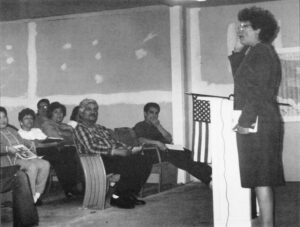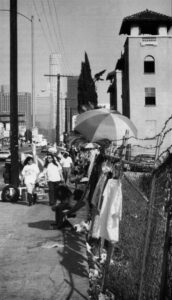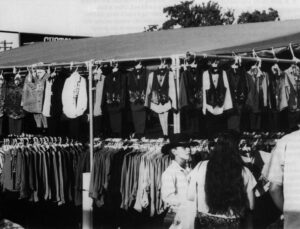According to the inscription on the Statue of Liberty, immigrants are the “tired… poor… the huddled masses yearning to be free, the wretched refuse of your teeming shore… the homeless, tempest-tossed.” Unfortunately, those words did not fit when Emma Lazarus wrote them in 1883, and they are even less accurate today. Despite the myths of immigration, the poorest of the poor, the most downtrodden and persecuted did not come to the United States during the last great wave of immigration. Things are not much different today.
The tempest-tossed were, and still are, just that. They are at the mercy of forces beyond their control. It is the others, the ones battling the storms, who end up taking trips. Immigrants are the ones who set their own course undaunted by the tempests. Throughout American history migrant streams have transported people with the means and ability to decide their own destinies.
Why aren’t very poor people the most likely to migrate? If not the poorest, then who does come?
Some answers emerge from several extensive surveys conducted among Mexican migrants both in Mexico and in the United States. Examining different populations and using a variety of methods over the course of nearly 30 years, several surveys came up with some remarkably consistent results.
Whether migrants leave from the cities or countryside, they tend to have high rates of employment before they leave, often in comparatively good jobs requiring some skills in the local context. Their schooling and earnings place them neither at the bottom nor at the top of their communities.
Even people who join the migrant stream as illegal aliens share these characteristics clearly indicating that they are not emerging from the most desperate sectors of society. Usually migrants have more education and more skilled occupations than their parents. Finally, migrants or their families have often moved at least once already within Mexico, and it is likely someone in the household has previously travelled north to theU.S. in search of work.
This portrait of the migrant does not fit the popular myth or the political rhetoric that forges an inextricable link between migration and poverty, but it does help explain some of the most important patterns in the current wave of migration. People who have managed to pull themselves up even just a little bit are likely to have different motivations and expectations than those stuck at the very bottom of the social ladder.
Moreover the surveys show that migrants typically do not make the decision to travel alone. Instead they usually operate as part of an extended network of relatives and friends. These family or community based networks not only facilitate travel but also provide it with a purpose. Often the goal of an individual’s migration is not realized in the improvement in their own life but rather with money sent home in the form of remittances.
To understand why migrants must rely on their relatives and why the poorest people in sending communities simply cannot migrate at all, one need only start by considering a hurdle that migrants have faced through the ages: the costs of travel.
Making a trip to Southern California from central Mexico might not seem very expensive, but a series of surveys supervised by Wayne A. Cornelius, director of the Center for U.S.-Mexican Studies at the University of California, San Diego, found that in the 1980’s the average person in a rural sending community had to save for more than five months to finance travel. Aside from transportation costs, these expenses often included the fees paid to a coyote, a smuggler who guides migrants on clandestine border crossings, and money to cover living expenses while the migrant looked for work. Additionally, there were the lost wages until the migrant got to the U.S. and found a job.
That price is too high for people living at a subsistence level of poverty. But it is a high price even for individuals living several steps beyond abject poverty, and the surveys show that most migrants finance the up front costs with money loaned or given to them by relatives.
Clearly, the people most likely to migrate are the ones best able to improve the odds of success when so much is put at risk.And, the most effective way of minimizing the risks is by migrating within a network made up of immediate family, kinfolk and hometown friends. Families are the brokerage houses of migration, the raise capital and spread risk. They vouchsafe the investment’s legitimacy, and when it produces a profit in the form of remittances sent home by the migrant, the family distributes dividends.
In the Cornelius surveys, people about to set off for the United States consistently said that having a job pre-arranged for them was the key factor in deciding whether or not to travel.In fact they considered the guarantee of a job more important that having legal immigration status, and overwhelming numbers of them said their guarantees of work came through family networks.
Among those in the Cornelius surveys who were considering migration for the first time 91 percent said they were aiming for destinations in the U.S. where relatives were already living and 95 percent said they had home town friends at their U.S.destinations. In many cases these connections had developed over a generation or more of regular migration by different members of a single household.
Such powerful networks provide not only the means for migration but also a motive. While the myths of migration laud the bold individual striving alone to make a new life, in fact the immigrants struggle is even more noble because it is a struggle on behalf of others. Growing evidence shows that immigrants past and present make their journeys as part of a family strategy for coping with economic change. And, what’s more important for policy makers, the results of that strategy are measured not in the migrant’s new land but in the home community that is left behind.
A series of studies conducted by The World Bank since the mid-1980’s has experimented with the notion that absolute income does not help explain why people migrate so much as “relative deprivation.” A great many surveys and econometric equations focused on rural Mexico developed a seemingly simple thesis:people measure their well-being by comparing themselves to their neighbors. Therefore, one major impetus to migration is to improve a household’s status relative to other households in its immediate surroundings. The goal of the migration is to raise money which raises the family’s standing in its home community.
This helps explain why migrants emerge not from the most abject households in a community but from those that have some realistic hope for advancement.
The idea of relative deprivation has several important implications. On a purely individual level it offers an econometric explanation for what seems a bit of common sense: Hopelessness rarely engenders dramatic actions. Rather, people take risks when they have some hope of success. As a result then, rising expectations are at least as much a stimulus to migration as descending ones and rising economies are as likely to produce migrants as the ones in a free fall. And, perhaps the likeliest-source of migrants is an economy that has lifted living standards somewhat and then dives into a crisis as was the case in Mexico in the 1980’s. Rising expectations are a powerful motivator, but unfulfilled expectations may be even stronger.
Also, under this scenario the migrant does not leave merely out of personal ambition or private necessity but as part of a household economic strategy. The migrant’s gains, therefore, are not measured only by achievement in the new land, but also rather by what is contributed to the welfare of those who remain behind. In this regard, migration can serve as a means to overcome, or rather to get around, the rigid impediments to economic and social mobility that characterize so many third world nations.
Consider the travels of Esteban Espinoza, a thin wiry man,25 years old, who grew up on a rancho, a small farm, in the Mexican state of Guerrero, where his family mostly raised corn. In the summer of 1993 he found himself standing on street corners near downtown Los Angeles that have become well-known day labor markets. During the course of the summer he did everything including painting, landscaping, and unloading trucks at garment district warehouses. The pay was always close to the minimum wage, $4.25 an hour, and always in cash.
Esteban figured that he wired home between $150 to $200 a week. Housing was a blanket on the floor of a church-run shelter. All his belongings fit into a small gym bag. Every day he spent at least 12 hours out working or looking for work.
“On Saturday I send back whatever I have and just keep $5 for myself and that is always enough until Monday or Tuesday and by then I’ve made some more,” he said.
Eleven adults and children live on the rancho.
“We raise a lot of different kinds of food and usually we have enough to eat but there is never much money. With someone up here working, there is money every week,” he explained.
One of Esteban’s grandfathers picked chilies and did railroad work in the U.S. many years back, he recalled, and his father had gone north for a time as well. In the more recent past, an elder brother was assigned to make the trip north to be the rancho’s cash cow, but he began staying in Los Angeles over the winters when he found a regular job. Then he married, and gradually his remittances dropped off. The task fell to Esteban who made two trips of a few weeks each in 1992 to visit his brother and to learn the business including how to jump the border.
On his own now, Esteban expected to stay in Los Angeles until the rains came in the autumn. Then he would go back to the rancho. “In the winter I will rest, and in the spring I will probably come back, and then I will find a real place to live, and real work and maybe I will stay for a year.”
Asked whether he would ever consider staying permanently in California the way his brother did, Esteban breaks a bit of a smile and says, “It depends on the future.” As powerful as his links to the rancho might have been at the moment, Esteban clearly did not consider them permanent.
Money sent home by people like Esteban is part of a massive and growing transfer of funds. This financial traffic is the most tangible supporting evidence for the idea that migration finds its fulfillment in economic strategies played out in the countries of origin.
According to World Bank estimates, the total value of remittances from migrants worldwide increased from $43.3 billion in 1980 to $65.5 billion in 1989. By 1993 the total was rapidly heading towards $70 billion despite the effects of a long recession in most industrialized economies, according to a United Nation’s estimate. This means that the money scrimped and saved and sent home by migrants amounted to the second largest form of international monetary flow in the world, coming in behind the oil trade ($240 billion in total exports in 1984) but well ahead of the next largest commodity, coffee ($9 billion on average in the early 1980’s).
Remittances from Mexican workers in the United States alone amounted to an estimated $3.2 billion in 1990, according to a study by the Mexican scholar Fernando Lozano Ascencio published by the Center for U.S.-Mexican Studies at the University of California, San Diego.
That is a fairly conservative figure considering that some calculations go as high as $6 billion, but even at this level remittances would easily exceed Mexico’s annual income from agricultural exports ($2.2 billion) and the value of foreign direct investment in the country ($2.6 billion).
The financial link between migrants and their home communities is not by any means a particularly Latin trait. Nations like Jordan and Egypt are just as dependent on remittances as Mexico. Nor is this massive dispatch of funds something new.
During the second half of 19th century, annual remittances from Irish migrants in the United States exceeded $8 million in some years. Considering those sums, the historian Patrick J. Blessing concluded, “large-scale Irish peasant movement to the New World, therefore, was not a mindless flight from intolerable conditions, but, within the limited range of alternatives, a deliberate departure of generally literate individuals who were very much concerned with the survival and well-being of family and friends remaining at home.”
The massive international flow of remittances tells us that migration is not merely an act of individual necessity but that it is often linked to the needs and demands of others. It is frequently part of an economic drama played out as much at home as in the United States. And, it takes place in a broad social and economic context that extends much beyond the individual migrant’s decision to travel.
@1994 Roberto Suro
Roberto Suro, a reporter for The Washington Post, is examining immigrant life in America.



